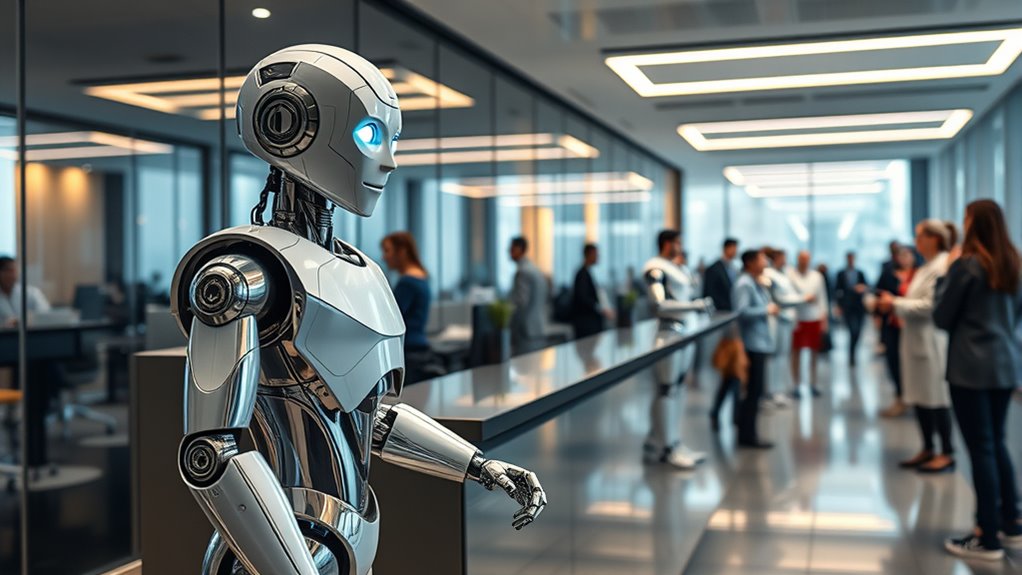While robots are becoming more common in workplaces due to their efficiency and versatility, many people still value human interaction for emotional connection, empathy, and personalized service. Generational differences influence acceptance levels, with younger folks more open but still concerned about job security. As technology advances, some tasks may always require a human touch, but understanding societal trends and ethics can help you see how this balance may evolve over time. Keep exploring to uncover how your role might change.
Key Takeaways
- Younger generations, like Gen Z, show high acceptance and trust in robot workers, indicating openness to technological integration.
- Many employees feel supported in learning AI skills, suggesting organizational efforts to foster acceptance of robot collaboration.
- Emotional attachment to human interactions remains a concern, especially in service roles requiring empathy.
- Societal fears about job displacement and privacy issues influence public attitudes towards robot workers.
- Transparent communication and ethical practices are crucial for increasing societal trust and acceptance of robotic workforce integration.
The Growing Presence of Robots in the Workplace
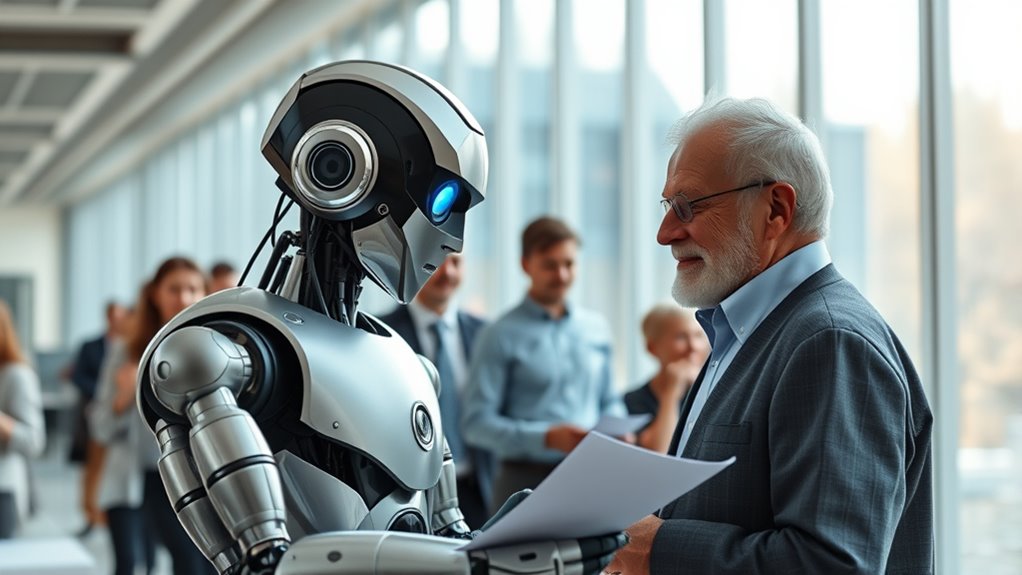
Have you noticed how robots are becoming more common in workplaces? They’re handling everything from assembly lines to delivery services, making operations more efficient. Thanks to technological advancements, robots now feature advanced sensors and AI, boosting safety and productivity. This shift isn’t just about replacing jobs; it creates new roles that focus on human skills. Industries like manufacturing see significant automation, but safety also improves—workplace injuries drop as robot use rises. You’ll find robots performing repetitive tasks quickly and accurately, freeing people for complex, creative work. They also support flexible staffing, including remote work setups. As robots become more integrated, your workplace will likely look different, emphasizing collaboration between humans and machines to stay competitive and safe. Additionally, understanding the contrast ratio of projectors can be important when designing visual displays in modern work environments. Furthermore, this increased automation encourages a workforce that is more adaptable and skilled in managing advanced technology. Moreover, fostering empathy and communication skills becomes vital as human roles evolve alongside robotic automation. To ensure smooth integration, companies are also investing in training programs that help employees develop new competencies aligned with technological growth. As the technology continues to develop, the importance of specialized knowledge in robotics and AI will become even more critical for future workforce planning.
Generational Attitudes Toward AI and Automation
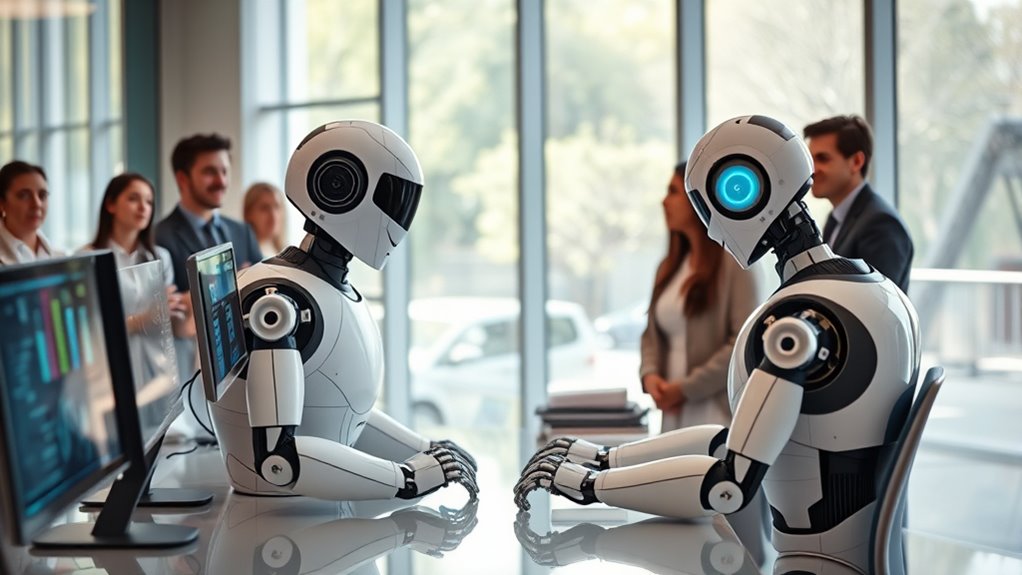
As workplaces become more integrated with AI and automation, different generations respond uniquely. Gen Z and millennials are more familiar with and open to AI tools, with 70% of Gen Z already using generative AI regularly. They tend to trust AI more and see it transforming daily work life. However, worries about job security persist, especially among frequent users, with half fearing AI might replace their tasks. Older generations, like Baby Boomers, have less trust and lower expectations for AI’s impact. Education and income also shape attitudes, with higher levels correlating with greater awareness and mixed feelings about AI’s benefits and risks. Exposure to cultural narratives in media shapes generational attitudes toward AI and automation, influencing acceptance levels. Additionally, ongoing discussions about asset division in legal contexts highlight the importance of transparency and understanding in emerging workplaces. Recognizing the role of media representations can further explain how societal perceptions of AI are formed and evolve over time. Furthermore, technological literacy varies across age groups, impacting how individuals interpret and adopt new AI innovations.
Perceived Strengths and Weaknesses of Robot Workers
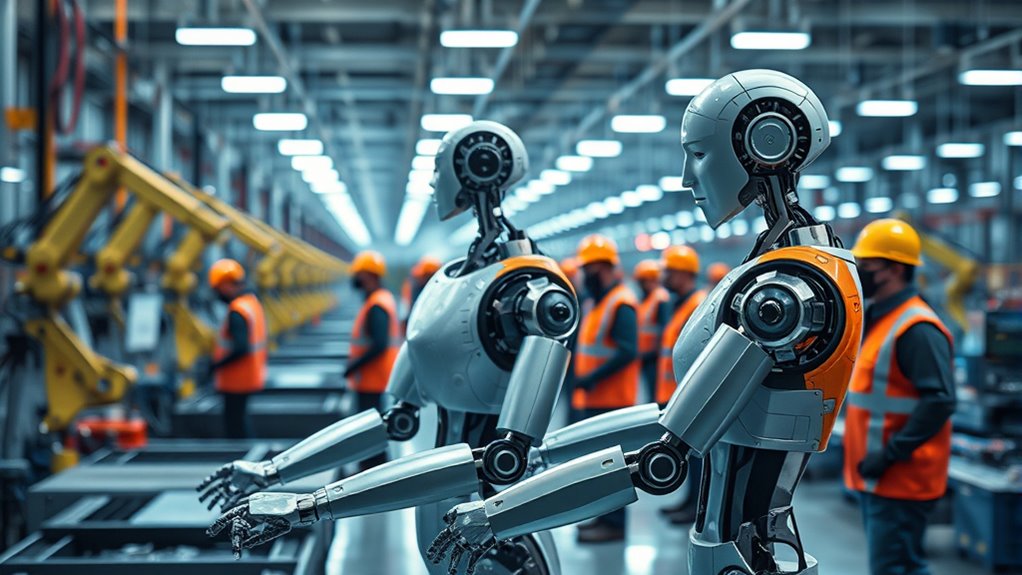
Robot workers offer a range of strengths that make them valuable assets in modern industries. They boost productivity by working 24/7 without breaks, streamlining production cycles. They also reduce workplace accidents by handling hazardous tasks, keeping workers safer. Robotics integration projected to lower operational costs, supporting more efficient manufacturing processes. Precision is a major advantage, minimizing errors and improving product quality. Robots excel at real-time data analysis, supporting smarter decision-making. Their flexibility allows them to be adapted for different tasks across various environments, increasing operational versatility. Additionally, advancements in Honda Tuning technology have demonstrated how precise adjustments can optimize performance, reflecting the importance of fine-tuning in complex systems. The evolving landscape of robotics continues to influence industries, pushing the boundaries of what automation can achieve. Furthermore, ongoing research into vertical storage solutions can enhance warehouse efficiency and space utilization, complementing robotic automation. However, weaknesses exist. Robots can displace jobs involving repetitive tasks, raising employment concerns. They require significant upfront costs and complex programming, which can be challenging. Additionally, they lack emotional intelligence, limiting their ability to handle roles demanding empathy. Dependence on technology also makes them vulnerable to failures or malfunctions. Robots have been shown to significantly reduce workplace injuries, highlighting another safety benefit.
Acceptance of AI Management and Autonomous Leadership
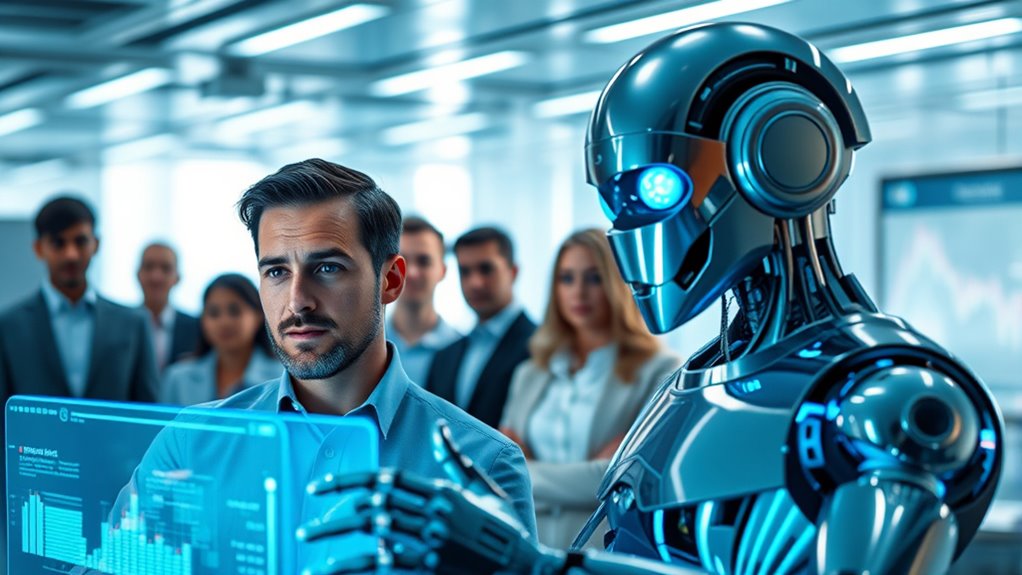
The integration of AI management and autonomous leadership is transforming how organizations operate, but it also sparks significant internal tensions. You’ll notice that 84% of employees feel supported to learn AI skills, showing strong organizational backing. Most leaders (70%) believe AI automation will soon surpass traditional methods, emphasizing its strategic importance. Managers see AI more as a tool to enhance human capabilities rather than replace jobs, yet concerns about job security persist. Tensions are common—66% of executives report internal power struggles, and 71% see siloed efforts leading to duplicated work. Debates over AI ownership and strategy alignment threaten cohesion. Additionally, fostering collaborative efforts can help mitigate some of these internal conflicts. Understanding change management strategies can facilitate smoother integration of AI systems within organizations. Incorporating trust-building initiatives and transparent communication can also play a crucial role in addressing employee concerns. Despite these challenges, 87% of leaders expect AI to positively impact operations, making autonomous leadership a key, if complex, driver of future growth. Incorporating beneficial ingredients like collagen and hyaluronic acid into AI strategies may also help address some concerns related to job security and employee well-being.
Variations in Automation Adoption Across Regions
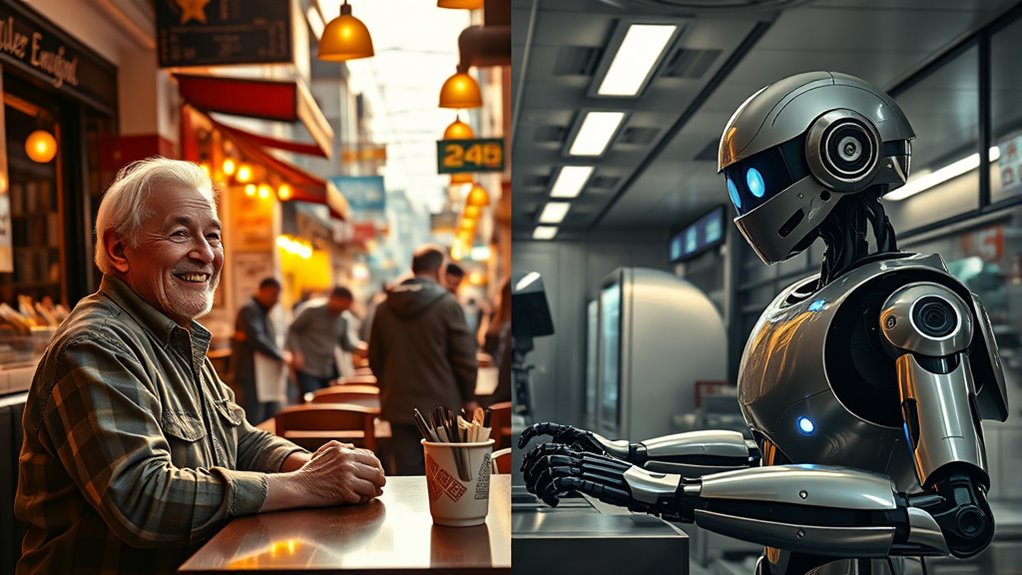
Global automation adoption varies considerably across regions, influenced by economic strengths, regulatory environments, and technological infrastructure. North America leads in AI adoption at 62%, thanks to strong investment and technological leadership. Europe adopts AI more cautiously, with a 48% rate, emphasizing ethical considerations and regulation. The Asia-Pacific region, driven by rapid innovation and government initiatives, shows significant progress, especially in China and India, where about 60% of IT professionals actively implement AI. Countries like the U.S. and China foster robust ecosystems, boosting AI use, while nations like Australia and the UK lag with adoption rates below 30%. Germany and France sit mid-range, reflecting varying priorities and capacities. These regional differences highlight how economic resources, policies, and infrastructure shape the pace and extent of automation adoption worldwide.
Technological Advances Shaping Future Employment
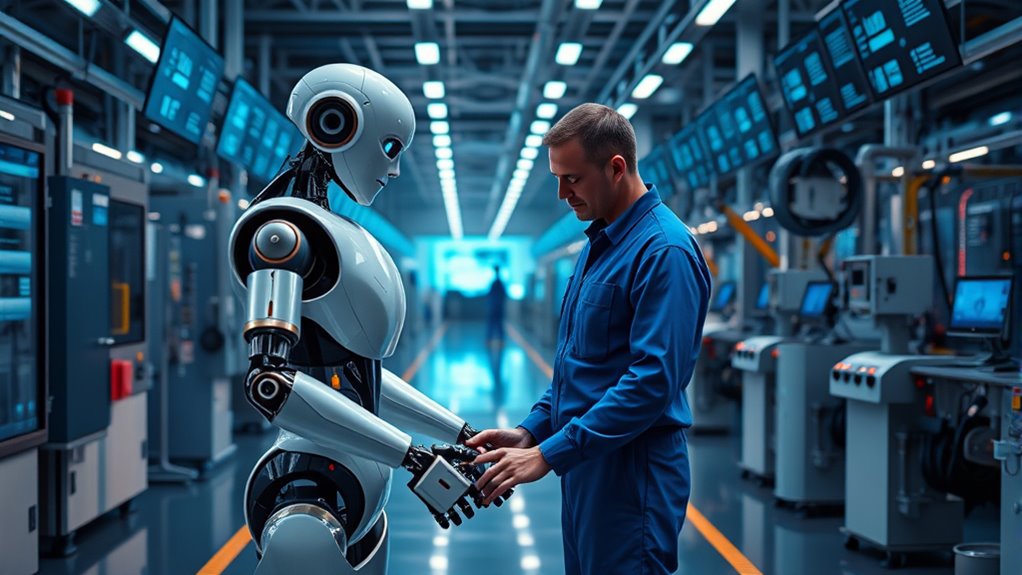
Advancements in AI and automation are rapidly transforming the workforce, creating new opportunities and challenges alike. You’ll notice that skills in AI and big data are increasingly in demand, with employers seeking professionals proficient in these areas. Automation, especially robotics, is expected to revolutionize industries, with 58% of employers viewing it as transformative. AI integration boosts efficiency and productivity across sectors, making technological literacy, data analysis, and critical thinking essential skills for the future. As AI becomes more embedded, job roles will evolve—creating new positions while phasing out others. To stay relevant, you’ll need to adapt through continuous learning and upskilling. These technological shifts are driving workforce transformation, emphasizing the importance of agility, digital access, and innovative approaches to work. Technological change is the main driver shaping employment trends through 2030.
New Opportunities and Challenges in Job Markets

As automation and AI reshape industries, your job market is evolving with both new opportunities and considerable challenges. While about 22% of jobs may be affected globally between 2025 and 2030, 14% of current employment—around 170 million jobs—will be created in emerging sectors like green energy, tech, and healthcare. Frontline roles such as farmworkers, drivers, and social workers are expected to grow markedly, offering new employment avenues. Meanwhile, automation will displace roughly 8% of jobs, but organizations plan to hire new staff to complement robot workers—91% expect to add positions in 2025. Robotics careers, including roles like software engineers and AI specialists, are predicted to expand significantly, emphasizing the importance of developing new skills. You’ll need to develop human-centered skills like resilience, leadership, and social influence to stay competitive in this shifting landscape. These changes present both opportunities for growth and challenges to navigate.
Ethical and Societal Implications of Automation
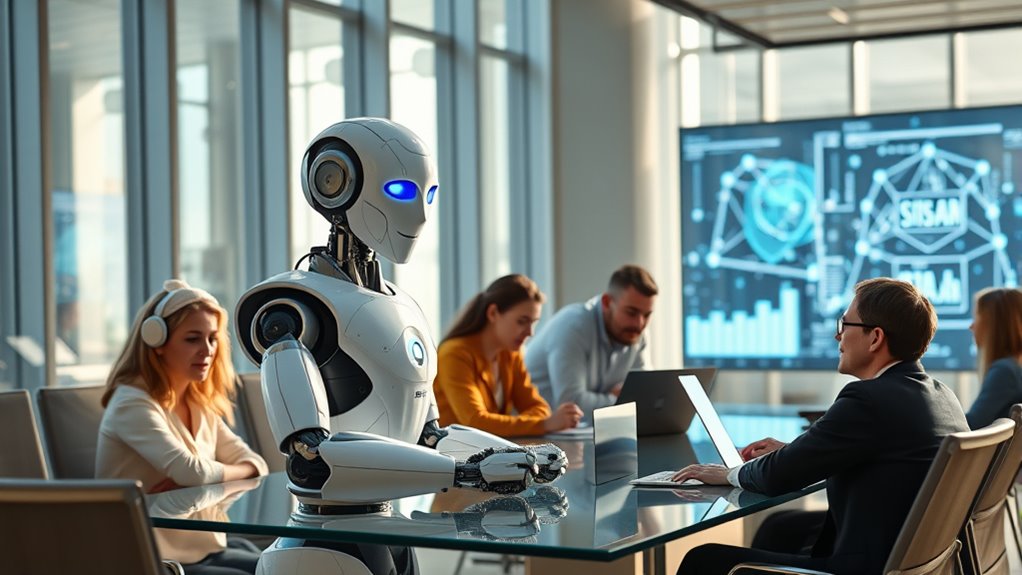
Automation raises complex ethical and societal questions that directly impact how you work and live. Job displacement is a major concern, as robots replace tasks once performed by humans, raising questions about the value of human labor. Safety remains critical; designing and maintaining robots to avoid accidents is essential. Privacy issues also emerge, especially with increased data collection in workplaces. You might worry about accountability—who’s responsible when autonomous robots malfunction? Societally, many people remain concerned about job loss, with 72% of Americans fearing automation will threaten employment. Emotional attachment to robots and dependency become social challenges, potentially affecting human interactions. To address these issues, governments and companies must develop clear regulations, invest in retraining, and ensure fair labor practices, balancing innovation with societal well-being.
Frequently Asked Questions
How Do Cultural Differences Influence Acceptance of Robot Workers Globally?
Cultural differences greatly shape how you accept robot workers worldwide. In some cultures, like Japan, you’re more open to robots due to positive media and historical exposure. In others, like Western countries, you might feel uneasy or fear job loss. Your cultural background influences your trust, expectations, and comfort with robots, affecting their integration into workplaces. Developers need to take into account these differences to ensure successful robot adoption across diverse societies.
What Measures Are Companies Taking to Ensure Ethical AI Deployment?
You see, companies are taking serious steps to ensure ethical AI deployment. They establish governance frameworks like CAIR, conduct bias audits, and promote transparency with explainable AI. They also embed human oversight, creating mechanisms for human-in-the-loop control. By collaborating with regulators and adopting privacy-preserving tech, they aim to prevent harm and build trust, guaranteeing AI benefits society responsibly and ethically at every stage.
Will Automation Lead to a Universal Minimum Wage or Income Guarantee?
They say, “Forewarned is forearmed,” and automation’s rise might push governments toward implementing a universal minimum wage or income guarantee. You could see this as a safety net for displaced workers, ensuring economic stability as machines replace human jobs. While challenging to fund, such policies could encourage innovation, helping society adapt to rapid technological changes. Ultimately, it’s about balancing progress with protections for everyone.
How Are Workers Adapting Their Skills to Coexist With Robot Colleagues?
You’re adapting your skills by learning to work alongside robots, focusing on tasks like problem-solving, judgment, and emotional intelligence that robots can’t easily replicate. You’re also gaining technical skills to operate and oversee cobots, ensuring safety and efficiency. Additionally, you’re strengthening interpersonal abilities to manage human-robot interactions, maintain workplace relationships, and stay relevant in evolving roles. This proactive approach helps you thrive in a collaborative environment with robot colleagues.
What Long-Term Psychological Effects Might Widespread Automation Have on Workers?
Widespread automation can lead you to feel more insecure, anxious, and disconnected from your work. You might find less meaning, achievement, and autonomy in your tasks, which harms your mental health over time. Social interactions could diminish, leaving you isolated and less supported by colleagues. These changes may cause long-term stress, burnout, and feelings of inadequacy, making it harder for you to find satisfaction and purpose in your career.
Conclusion
As you watch robots become part of your work life, remember that “the proof of the pudding is in the eating.” While automation brings efficiency and innovation, your human touch remains irreplaceable for empathy, creativity, and judgment. Embracing change doesn’t mean losing what makes us uniquely human. By balancing technology with your skills, you’ll navigate the future of work confidently, knowing that progress is best when it’s a team effort—machines and people working hand in hand.
